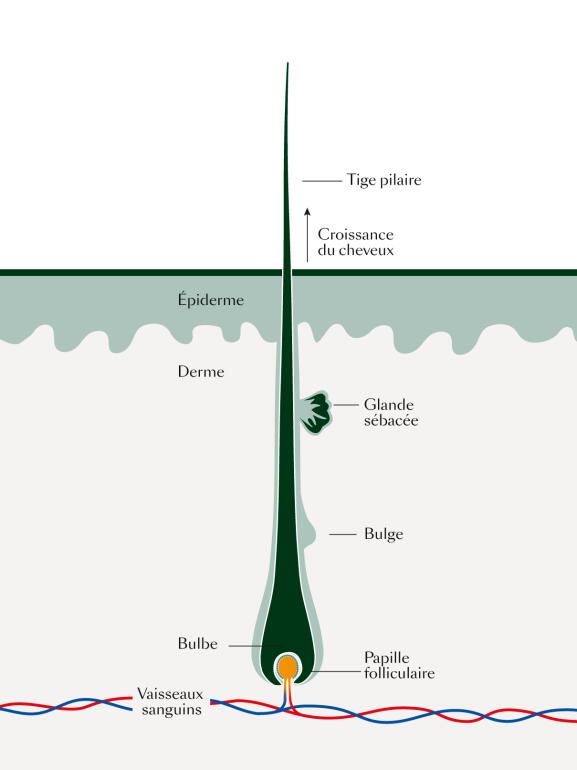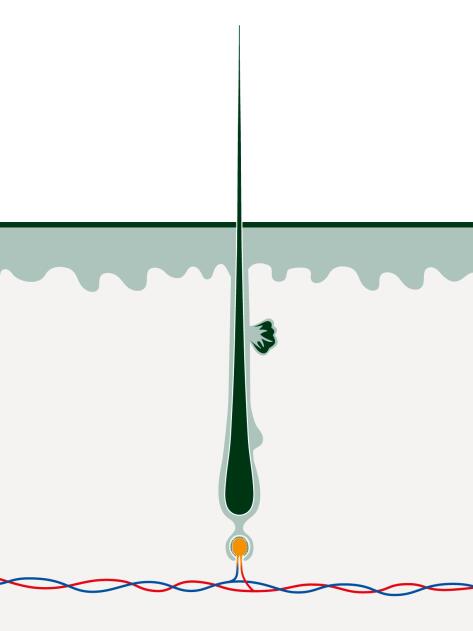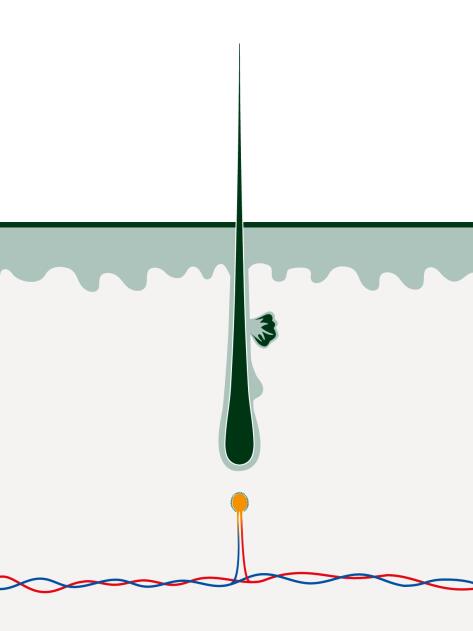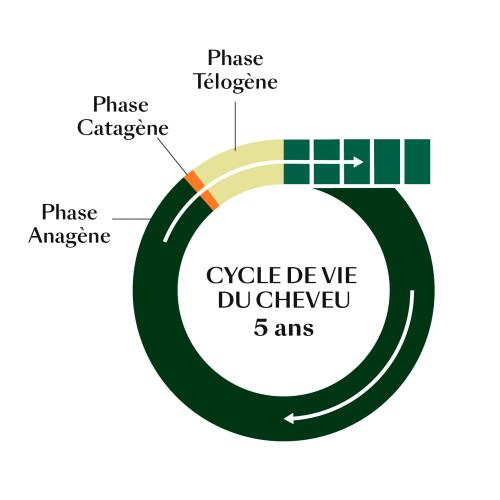
The life cycle of hair
The life cycle of hair is punctuated by a succession of phases during which it grows, lasts, regresses, and finally falls out.
Today, beyond the image of good health that it conveys, hair is considered a true adornment, a powerful symbol of seduction. It is at the heart of women’s aesthetic concerns, of course, but also men’s. You take care of it, you style it, you play with its color, its volume... depending on trends or your mood.
But we must not forget that the main function of the hair is physiological: it’s there to protect the surface of the scalp, which itself protects the skull.
We have between 100,000 and 150,000 hairs on our head. When the hair is in its growth phase, each hair grows on average one centimeter per month.
Unlike other animal species, human hair follicles are asynchronous. This means that each hair grows independently of the others.
Phase after phase, one hair pushes out another...
Our hair is constantly being renewed.
A hair appears, grows, and then falls out, following a hair cycle, which is repeated about 25 times during a lifetime.
This cycle has three successive stages.
The hair grows
The growth phase of the hair is called the anagen phase.It lasts about 3 years in men and 5 years in women.
It is characterized by intense metabolic activity in the hair bulb, which results in the formation of keratin, the essential protein that makes up the hair.
The matrix cells of the hair bulb actively multiply to form the hair and the epithelial sheaths.
Under normal living conditions, approximately 85% of the hair is in the anagen phase.
The scalp’s vascular network that feeds the hair root is then particularly well developed around the follicle.
The bulb is large, dark and surrounded by translucent epithelial sheaths.
This phase is regulated by hair follicle growth factors necessary for healthy, strong hair growth.

The hair persists, then dies
It is then the turn of the catagen phase, also called the regression phase. It is quite short (only 2 to 3 weeks) and concerns 1% of the hair.
This is the transition phase between the growth phase and the resting phase.
Through a phenomenon of programmed death, the hair follicle regresses, involutes and becomes inactive. The physical link between the follicular papilla and the bulb is broken. The matrix dies and, although the hair no longer grows, it remains rooted in the follicle for some time.

The hair falls out
Before falling out, the hair is in a resting phase or telogen phase.
This phase takes place over 2 to 3 months.
The dead hair remains anchored in the follicle for about 3 months. It has detached from the follicular papilla and slowly progresses towards the outside of the scalp until it falls out.
It falls out when it is pushed out by a new, young hair, for which a new anagen phase begins.
This renewal period affects 14% of the hair.

A new hair replaces it
As long as the hair's capital of life cycles (about 25) is not exhausted, a new hair can start a new cycle.

And so on...
If all goes well, these three phases follow each other at a regular pace. The capital of 25 cycles allows a woman to have beautiful hair for 125 years and a man for at least 75 years.

Unless something happens that throws everything off!
External or internal factors can affect the regularity, and therefore the duration, of hair cycles.
This action on the hair cycles can lead to hair loss. There are two main types:
- progressive hair loss, which takes place gradually
- reactive hair loss, which is sudden and occurs in reaction to an event.
In the case of reactive hair loss, there is a rapid and sudden transition from the anagen phase to the catagen phase and then to the telogen phase. The hair is therefore suddenly in a state of loss.
Approximately three months after the imbalance or shocking event that causes this premature transition to the telogen phase, the hair falls out in a massive and impressive way. This three-month delay corresponds to the duration of the telogen phase itself: the time it takes for the hair to travel from the moment it detaches from the follicular papilla until it is pushed out of the scalp.

This type of hair loss is temporary and does not lead to baldness. By quickly reactivating a new hair cycle, hair loss can be effectively stopped and new hair growth can be started.

In the case of progressive hair loss, or male- or female-pattern baldness, it is a disturbance of the male hormones in the body that causes the cycles to go haywire.
This imbalance leads, in both men and women, to a disturbance of the hair cycle, which results in a consequent shortening of the anagen phase.
Because this growth phase is shorter, the hair moves too quickly into the catagen phase and then into the telogen phase. This is what’s known as "runaway." The life cycles of the hair follow one another at a frenetic pace.
The hair capital, normally programmed to last a lifetime, is prematurely depleted. This accelerated process, if left unchecked, leads to irreversible baldness.

HOW BAD IS IT, DOCTOR?
"Should I look after my scalp in the same way as my hair or my skin?"
Jeanne, 29 years old
Hidden by the hair, the scalp is too often forgotten. But it's a living part of our body! The scalp can be damaged without us even realizing it. It is therefore important to look after it. Beautiful hair comes first and foremost from a healthy and toned scalp that breathes.
